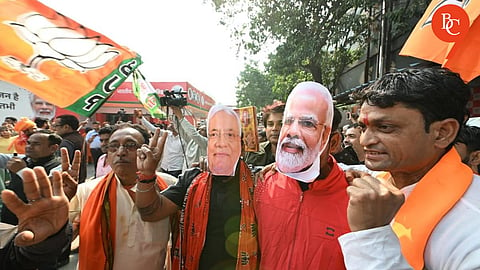

The BJP-led NDA is poised for a sweeping win in the 2025 Bihar Assembly elections, having won 204 seats in the 243-member Assembly, exceeding the essential majority threshold. This puts the Opposition Mahagathbandhan in a difficult position with just 32 seats.
What was the NDA's performance like in constituencies in Bihar with a significant Muslim population?
In a surprising turn in Bihar's political scene, initial counting trends on Friday showed the National Democratic Alliance (NDA) gaining unexpected ground in several constituencies with predominantly Muslim populations—areas traditionally supportive of secular parties. This development signifies a significant shift in voter behavior and suggests profound structural transformations in the state's political dynamics.
Is the NDA Making Progress in Constituencies Predominantly Muslim?
Preliminary numbers suggest that the NDA is poised to win at least 16 seats in Muslim-majority areas, a scenario that was once considered unlikely in past elections. Nitish Kumar's Janata Dal (United) has notably gained, capturing approximately eight more seats compared to its 2020 count.
Chirag Paswan’s LJP (Ram Vilas) is also registering notable gains, leading in six constituencies with significant Muslim electorates.
What Challenges Is the Mahagathbandhan Facing in Its Traditional Areas?
Although the Mahagathbandhan (MGB) focused its campaign on generating employment and introducing a new candidate for the Chief Minister's position, it seems to be struggling to maintain its traditional support. Recent trends indicate that the RJD is likely to lose seven seats with a significant Muslim population that it had won in 2020, and the Congress is falling behind in four similar seats it had previously held. In the 2020 Assembly elections, the RJD had won 18 of these constituencies, while the Congress had won six.
What is the historical significance of the Muslim vote?
Muslim voters have traditionally backed secular coalitions in Bihar. According to a 2022 state survey, Muslims make up 17.7% of the population, and historically, about 80% of them voted for the MGB in 2015, with 77% maintaining this trend in 2020.
This consistent backing formed the backbone of the coalition’s electoral arithmetic, until now.
What Accounts for This Change in Voting Patterns?
The NDA's current success is driven by two key factors:
1. The consolidation of alliances within the NDA, forming a cohesive pro-incumbency group.
2. The division of the Opposition vote, aided by the Jan Suraaj Party (JSP) and AIMIM, which hindered the MGB's efforts to turn anti-incumbency feelings into votes. Poll strategist Prashant Kishor's Jan Suraaj Party, once considered an 'X factor,' has essentially collapsed. Meanwhile, Asaduddin Owaisi's AIMIM has emerged as an unexpected 'dark horse,' leading in six seats, supported by strong Muslim backing in Seemanchal.
In what ways did the NDA create a more varied alliance?
The NDA’s strategy reflects a meticulously crafted caste-community architecture:
The BJP strengthened its core support among upper castes.
The JD(U) brought together EBCs, non-Yadav OBCs, Mahadalits, and mobilised women voters.
The LJP(RV) concentrated on the Pasi and other Dalit communities.
Smaller allies garnered backing from Dalit and Koeri groups.
In contrast, the MGB's efforts, based on the RJD's Yadav-Muslim base, along with the Congress and Left parties, were numerically inadequate.
